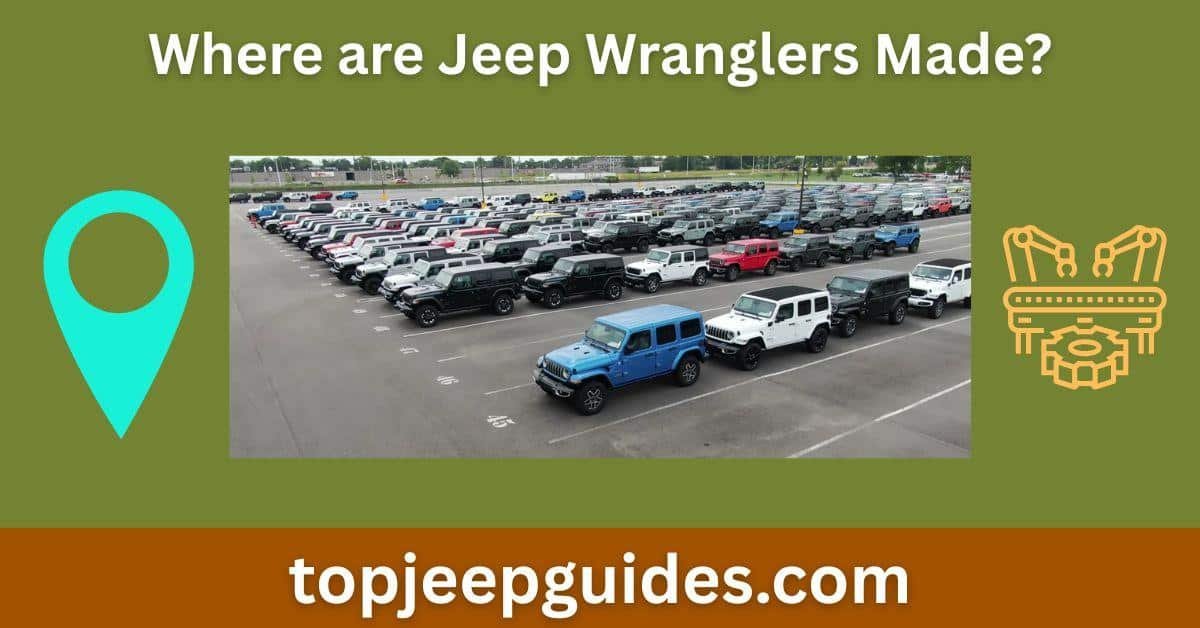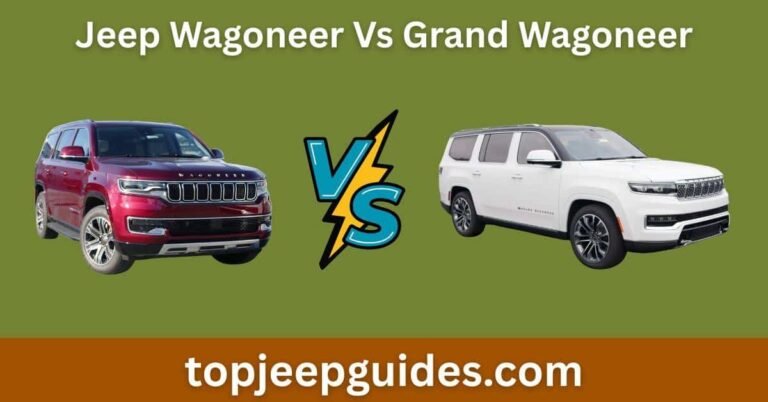Where are Jeep Wranglers Made? (Uncovering Production Secrets)

Jeep Wranglers mainly made in Toledo Assembly Complex in Toledo, Ohio, USA.
The first time I saw a Wrangler tackle a muddy trail in Colorado, I was hooked. That machine didn’t just drive—it roared freedom.
A few years later, I met a guy on that same trail who swore his Wrangler was made in Italy. I laughed—until I realized he wasn’t entirely wrong.
Jeep Wranglers are global icons. But ask even a die-hard fan where they’re actually made, and you’ll hear a dozen different answers: “America!” “Brazil?” “Maybe China?”
So, what’s the real story?
Knowing where your Wrangler was born isn’t just trivia—it’s about legacy, pride, and the craftsmanship behind every rugged curve.
And let’s be honest—you don’t buy a Jeep just to drive. You buy it to legally escape traffic laws (kidding… mostly).
Jeep Wrangler Production Locations
Wranglers = Freedom. Adventure. History. But where does the journey begin?
Toledo, Ohio: The Heart of Wrangler Manufacturing
In my opinion, there’s something unbeatable about knowing your Jeep came from the same factory that’s been perfecting the craft for decades.
Yes, it all starts here—Toledo, Ohio. Often referred to as the “Home of Jeep,” this iconic city hosts the Toledo Assembly Complex, where the majority of Jeep Wranglers are crafted.
“Every Jeep that rolls off the line in Toledo carries decades of tradition, innovation, and American pride.”
According to Wikipedia, Roughly 68% of all Jeep Wranglers sold in the U.S. have been assembled in Toledo, Ohio, highlighting its critical role in maintaining Jeep’s legacy.
Here, thousands of skilled workers blend modern tech with old-school craftsmanship to produce these off-road beasts. If you’re ever near northern Ohio, it might be worth a detour to see the birthplace of your adventure machine.
International Assembly Plants
While Toledo remains the epicenter, Jeep has expanded its production footprint globally to meet rising demand.
Italy, Brazil, China, India, and Mexico
- Brazil, Italy, China, Mexico, and India have localized facilities that assemble Wranglers for their regions.
- These international hubs ensure Jeep stays agile, adapting vehicles to local preferences and market regulations.
Curious how your Wrangler might differ from a global counterpart? Take a closer look at the trim, tech, or safety packages!
Historical Evolution of Manufacturing
The Jeep brand has a storied past, and its factories have evolved in tandem with global demand and tech innovation.
Early Days in Toledo
It all began in a modest facility in Toledo, where the first civilian Jeeps were born post-WWII. The passion of those early workers helped lay the foundation for the Wrangler’s legendary reputation.
Expansion and Modernization
Starting in the 1980s, Jeep began expanding its operations and embracing modern manufacturing technologies. This led to:
- Increased production speed
- Improved build quality
- A growing global presence
The Toledo Assembly Complex has since been upgraded multiple times, blending state-of-the-art robotics and automation with skilled human labor to meet rising global demand for the Jeep Wrangler.
Jeep Wrangler Production & Sales Stats
According to CBT News, over 250,000 Wranglers 4xe were produced in Toledo in 2025 alone, showcasing just how far production capabilities have scaled.
On the other hand:
According to Stellantis North America, as of late August 2023, Jeep reached a historic milestone with its five million Jeep Wrangler sold worldwide since the model’s debut in 1986. And, over 80% of those five million Wranglers have remained on the road—testament to their legendary longevity.
Manufacturing Process Insights
“Ever seen a Wrangler in a tuxedo? Neither have I. But it sure knows how to dress for mud.”
So, how is a Jeep Wrangler actually built? Let’s pull back the curtain.
Design and Engineering
Everything starts with a vision.
- Engineers design each Wrangler to balance off-road toughness with on-road comfort.
- Every component—from the signature grille to the durable suspension—is tested and refined using advanced simulations.
Assembly Line Efficiency
At the factory:
- Robots assist with welding, painting, and part assembly.
- Skilled humans ensure everything aligns with Jeep’s high standards.
- Each step is choreographed for maximum efficiency without compromising quality.
Rigorous Quality Control
Before it ever hits the lot, each Wrangler is put through a gauntlet of quality checks:
- Structural tests
- Functionality checks
- Safety inspections
“Only when it passes every test does it earn the Jeep badge.”
Supply Chain and Material Sourcing
Building a Jeep isn’t just about assembly—it starts with the right raw materials and components.
Key Suppliers
Jeep partners with top-tier global suppliers for:
- Engines and transmissions
- Advanced electronics
- Rugged off-road parts
These suppliers are handpicked for reliability, consistency, and quality.
Smart Sourcing Strategies
Jeep’s sourcing focuses on:
- Ensuring high availability
- Reducing costs
- Supporting sustainable practices
That’s why you’ll find eco-friendly materials and ethical sourcing policies playing a growing role in Jeep’s manufacturing ethos.
Environmental and Sustainability Practices
What’s an adventure vehicle without wild landscapes to explore?
Built responsibly, with a focus on sustainability—just the way it should be.
Eco-Friendly Initiatives
- Water recycling systems help reduce usage and protect local ecosystems.
- Waste reduction programs minimize landfill contribution.
Energy Efficiency
The factories themselves are going green with:
- Smart lighting
- Energy-efficient machinery
- Carbon footprint tracking
Impact on Local Economies
Honestly, I think local manufacturing builds trust—and pride.
Wrangler production doesn’t just make great vehicles—it powers entire communities.
Job Creation in Toledo
- Thousands are employed in and around the Toledo Assembly Complex.
- Wages, benefits, and economic activity support local businesses and families.
Community Engagement
Jeep actively supports:
- Local schools
- Charities
- Events and sponsorships
This deep local involvement fosters loyalty, pride, and a strong community backbone.
Future Trends in Wrangler Production
What does the future hold for this rugged icon?
Technological Innovations
- Automation will boost efficiency.
- Electric & Hybrid Wranglers are coming—off-roading with a smaller carbon footprint!
How would you feel about a silent, zero-emission Wrangler climbing a rocky trail?
Global Expansion
Expect more localized production:
- Shorter delivery times
- Vehicles tailored to regional laws and lifestyles
It’s all part of Jeep’s “think global, act local” philosophy.
Frequently Asked Questions
Are Jeep Wranglers Made Outside The USA?
Yes, Wranglers are also assembled in countries like Brazil, Italy, China, Mexico, and India to serve local markets. However, the primary production hub remains in the USA.
How Has Jeep Wrangler Production Evolved?
Production began in the USA but expanded globally to meet demand. Today, Jeep uses modern technology and international facilities to improve efficiency and maintain quality.
What Makes Toledo Ideal For Jeep Production?
Toledo’s strong Jeep legacy, skilled workforce, and strategic location make it ideal. Its advanced factory setup ensures efficient, high-quality Wrangler production.
Are U.S.-made Wranglers Better than International Ones?
Not better, just different. U.S.-made Wranglers are known for consistency, while international ones are tailored for local laws and preferences. All meet Jeep standards—just adapted for different roads and drivers.
Will Future Wranglers be Made Entirely Electric?
Yes, electric Wranglers are coming soon. The 4xe hybrid is already out, and Jeep plans to electrify the whole lineup by decade’s end—bringing silent off-roading and instant torque.
Final Thoughts
The Jeep Wrangler is more than a vehicle—it’s a story of heritage, innovation, and passion. Whether yours came from the heart of Ohio or from an international plant, one thing’s certain:
It’s built to explore. Built to endure. Built to inspire.






